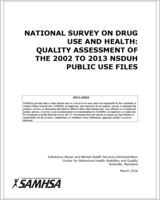All material appearing in this report is in the public domain and may be reproduced or copied without permission from SAMHSA. Citation of the source is appreciated. However, this publication may not be reproduced or distributed for a fee without the specific, written authorization of the Office of Communications, SAMHSA, HHS.
NCBI Bookshelf. A service of the National Library of Medicine, National Institutes of Health.
Substance Abuse and Mental Health Services Administration. National Survey on Drug Use and Health: Quality Assessment of the 2002 to 2013 NSDUH Public Use Files [Internet]. Rockville (MD): Substance Abuse and Mental Health Services Administration (US); 2016 Mar.

National Survey on Drug Use and Health: Quality Assessment of the 2002 to 2013 NSDUH Public Use Files [Internet].
Show detailsThe National Survey on Drug Use and Health (NSDUH)1 is on ongoing series of annual national surveys that collect data on substance use, mental health, and other health outcomes among members of the U.S. civilian, noninstitutionalized population aged 12 years old or older. It is sponsored by the Substance Abuse and Mental Health Services Administration (SAMHSA), U.S. Department of Health and Human Services, and is planned and managed by SAMHSA’s Center for Behavioral Health Statistics and Quality (CBHSQ). Data collection and analysis are conducted under contract with RTI International.2 NSDUH data have been used extensively by researchers to study behavioral health issues (e.g., alcohol use, tobacco use, marijuana use, prescription drug misuse, heroin use, and mental health issues). Data show that over 9,000 studies have used NSDUH for research in the field of substance use and mental health in the United States, and that research has resulted in over 1,700 publications from 1983 through 2015.3 To meet the increasing needs of researchers at large, NSDUH public use files (PUFs) have been created using a statistical disclosure control technique called MASSC to protect confidentiality of the data. MASSC stands for Micro-Agglomeration, Substitution, Subsampling, and Calibration (Singh, 2002; Singh, Yu, & Dunteman, 2003; Singh, Yu, & Wilson, 2004). MASSC has been successfully used to create NSDUH PUFs since 1999 to control both disclosure risk and information loss. Although quality assessment was conducted before releasing each NSDUH PUF to the general public, no formal report had been published until now to document the impact of disclosure treatment on the quality of NSDUH data.
The objective of this methodological report is to inform researchers that NSDUH’s PUFs maintain high data quality and comparability with NSDUH’s restricted-use files (RUFs), which will provide confidence to researchers and policymakers for making policies and public health decisions based on PUF data. NSDUH PUF data quality assessment and comparability with the NSDUH RUFs have been achieved in this report by performing multiple comparisons of key estimates produced from the two sets of 2002 to 2013 data files. About 200 tables of substance use and mental health estimates and their respective standard errors (SEs) were compared (136 tables of substance use estimates and 60 tables of mental health estimates). Summary statistics of the ratios of the estimates and the ratios of their SEs from the PUF data and the published tables were produced. In addition, global utility measures, such as Hellinger’s distance (HD) (Dohrmann, Krenzke, Roey, & Russell, 2009) and relative root mean square error (RRMSE), were compared across years for some outcome and domain combinations. This methodological report demonstrates the overall quality of NSDUH’s PUFs and mentions any limitations that were identified, so that researchers and other policy makers can continue to derive sound policy-relevant and empirically based conclusions from the PUFs.
In Chapter 2, an overview of the NSDUH disclosure concerns and MASSC treatment is presented, followed by a summary of the study’s quality control, assessment, and research objectives. Chapter 3 discusses how the data tables were selected and replicated, as well as the methods that were used to compare the NSDUH PUF and RUF estimates. Chapter 4 describes various approaches (e.g., ratios, HD, RRMSE, trends) used for NSDUH data quality assessment and analysis results and presents comparisons of estimates between the PUFs and RUFs. Chapter 5 discusses the quality of the PUF data and mentions the limitations of the NSDUH PUFs. A brief conclusion is provided in Chapter 6. Also, four appendices are included. Appendix A lists which NSDUH detailed tables and mental health detailed tables were selected as the source for the RUF estimates for comparison with the PUF estimates. NSDUH’s suppression rules are summarized in Appendix B. In the final two appendices, the 2002 to 2013 substance use tables Appendix C and the 2009 to 2013 mental health tables (Appendix D) are provided; these tables were produced with the RUF and PUF estimates and their SEs, as well as the ratios of the estimates and the ratios of their SEs.
Footnotes
- 1
For more information on NSDUH, see http://www
.samhsa.gov/data/. - 2
RTI International is a registered trademark and a trade name of Research Triangle Institute.
- 3
For more information on NSDUH data citations, see http://www
.icpsr.umich .edu/icpsrweb/ICPSR /biblio/series/64/resources?sortBy=1.
- Introduction - National Survey on Drug Use and HealthIntroduction - National Survey on Drug Use and Health
Your browsing activity is empty.
Activity recording is turned off.
See more...